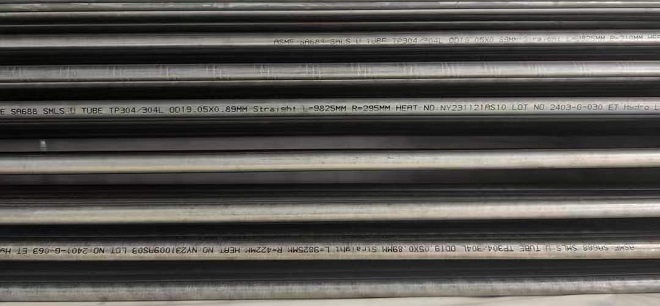Categories
- Technical & Application (25)
- Steel Tubing (20)
- Alloy Tubing (8)
ASTM A688 welded stainless steel tubes are usually furnished in the form of U tubes for application in tubular feedwater heaters. According to the supplementary requirement S1, each welded tube in finished condition prior to bending, shall be tested by passing it through an electric nondestructive tester capable of detecting defects on the entire cross section of the tube. This NDT method is called eddy current test (ECT). Two common yet serious defects that may occur in welded stainless steel tubing are weld inclusions and transverse cracks. These defects, although rare, can be detected using eddy current testing.

Wooden-case packaged ASTM A688 TP304L welded U tubes.
Weld inclusions are foreign materials trapped within the weld metal. These could include slag, tungsten, flux, or other impurities that were not properly removed or controlled during the welding process. Inclusions can create weak points in the weld, compromising the mechanical properties and integrity of the tubing. This can lead to failure under stress or pressure, especially in critical applications like heat exchangers or boilers.

ASTM A688 TP304/304L dual-certified welded tubes, (OD)19.05mm x (WT)0.89mm x (Straight L)9825mm, (R)295mm, supplied to the UK.
Transverse cracks are cracks that run perpendicular to the direction of the weld or the tube’s axis. They can occur due to thermal stresses, improper cooling rates, or other metallurgical factors during or after welding. Transverse cracks are particularly dangerous because they can propagate quickly under stress, leading to sudden and catastrophic failure of the tubing. Given that ASTM A688 welded stainless steel feedwater heater tubes are usually working in high-pressure & high-temperature environments, even a small crack can rapidly expand, resulting in leaks or bursts.

Eddy current testing facilities for welded stainless steel tubes in our mill.
Eddy current testing (ECT) is a non-destructive testing (NDT) method that uses electromagnetic induction to detect flaws in conductive materials, like welded stainless steel tubing. During ECT, a coil carrying an alternating current is placed near the surface of the tubing. This generates a magnetic field, which induces eddy currents in the material. If there are defects like inclusions or cracks, they will disrupt the flow of eddy currents, which can be detected as changes in the impedance of the coil. ECT is highly sensitive to surface and near-surface defects, making it ideal for detecting possible weld inclusions and transverse cracks in ASTM A688 welded tubes. It can quickly scan long lengths of tubing, providing immediate feedback and allowing for the identification of defects that might not be visible to the naked eye. Eddy current testing (ECT) is essential for ensuring the welding quality of welded tubes by detecting significant discontinuities, especially of the short abrupt type. It shall be performed in accordance with ASTM A1016 using the methods specified in ASTM Practices E309 and E426.